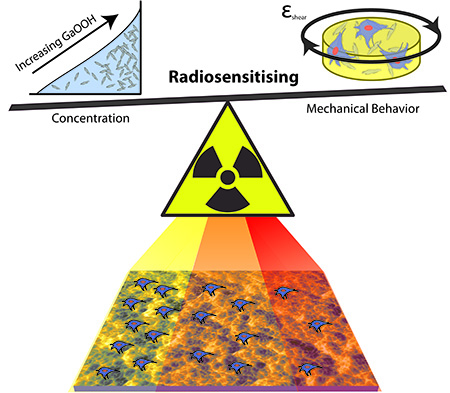Researchers Can Tune Mechanical Properties of Radiation-Sensitive Material for Biomedical Use
For Immediate Release
An interdisciplinary team of researchers at North Carolina State University has developed a composite material that emits light and heat when exposed to specific wavelengths of radiation and that can be customized to have specific mechanical characteristics. The composite holds promise for use in biomedical imaging, drug delivery and therapeutic treatments.

“The radiosensitivity is what makes the material useful for biomedical applications, and the ability to tune the mechanical properties makes it less likely to be rejected by the surrounding tissue in the body,” says Nora Berg, a Ph.D. student at NC State and lead author of a paper describing the work.
The material is a composite of a biological gel made of proteins and gallium oxyhydroxide (GaOOH), which is a semiconductor material. Specifically, the GaOOH is dispersed in the biological gel in the form of crystals that are 200-300 nanometers in diameter and approximately one micron – or micrometer – in length.
“When the composite is exposed to wavelengths of radiation that would be used in clinical settings, the GaOOH responds by heating up and emitting light,” Berg says.
“This response to radiation makes it attractive for use in some therapeutic applications,” says Albena Ivanisevic, corresponding author of the paper and a professor of materials science and engineering at NC State. “The radiosensitive response can help generate reactive oxygen species – like peroxide – that can be used to kill cells. So, this material may have value for targeting localized cancer sites.”
The mechanical properties of the composite can be tuned by adjusting the concentration of GaOOH; adjusting the amount of GaOOH changes the structure of the gel, which affects the gel’s stiffness. The mechanical properties were investigated in collaboration with Saad Khan’s research group in NC State’s Department of Chemical and Biomolecular Engineering.
To determine how the composite may interact with cells, the researchers did a proof-of-concept study. First, the researchers grew mouse-derived connective tissue cells – called fibroblasts – on the surface of composite samples. They then worked with researchers in NC State’s College of Veterinary Medicine to expose the cell-covered samples to different amounts of clinically-relevant radiation.
The researchers found that higher doses of radiation increased cell death – but so did higher concentrations of GaOOH.
“This means that you can increase the concentration of GaOOH in the composite to cause cell death at targeted sites, while using less radiation,” Ivanisevic says.
The researchers now plan to evaluate how the composite works with other cell types, such as neuronal cells, that are more resistant to radiation.
“The composite is relatively inexpensive and easy to make, and could be scaled up,” Ivanisevic says. “It’s important to note that, while this has practical applications, it is fundamental work – we are still in the in vitro testing stage. A lot of work lies ahead before this will be viable for clinical use.”
The paper, “Interfaces with Tunable Mechanical and Radiosensitizing Properties,” is published in the journal Applied Materials & Interfaces. The paper was co-authored by NC State Ph.D. students Brady Pearce, Patrick Snyder, Nathaniel Rohrbaugh and Prajesh Adhikari; Michael Nolan, an assistant professor of radiation, oncology and biology at NC State; and Saad Khan, Alcoa Professor of Chemical and Biomolecular Engineering at NC State.
-shipman-
Note to Editors: The study abstract follows.
“Interfaces with Tunable Mechanical and Radiosensitizing Properties”
Authors: Nora G. Berg, Brady L. Pearce, Patrick J. Snyder, Nathaniel Rohrbaugh, Michael W. Nolan, Prajesh Adhikari, Saad A. Khan, and Albena Ivanisevic, North Carolina State University
Published: Feb. 16, Applied Materials & Interfaces
DOI: 10.1021/acsami.5b11639
Abstract: We report the fabrication of a composite containing nanostructured GaOOH and Matrigel with tunable radiosensitizing and stiffness properties. Composite characterization was done with microscopy and rheology. The utility of the interface was tested in vitro using fibroblasts. Cell viability and reactive oxygen species assays quantified the effects of radiation dosages and GaOOH concentrations. Fibroblasts’ viability decreased with increasing concentration of GaOOH and composite stiffness. During ionizing radiation experiments the presence of the scintillating GaOOH triggered a different cellular response. Reactive oxygen species data demonstrated that one can reduce the amount of radiation needed to modulate the behavior of cells on interfaces with different stiffness containing a radiosensitizing material.
- Categories:


